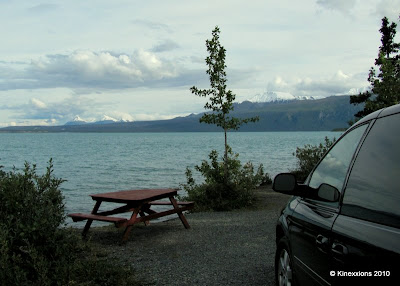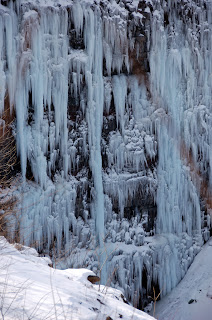Here is a quick comparison on two of the best inlight weight hard shell technology available today.
I added a third shortly after:
http://coldthistle.blogspot.com//01/a-third-shell-material-westcombs-focus.html
Any of the threecan be easilyused for most anysport where you need someprotection from nasty weather,including climbing. In the case of my buddy Dave and I, ice climbing for sure but lift/side-hill on a snow board or skis as well or a quick run on the bikes.
It was no accident that we both showed up for a reunion at our once home townski area kitted in similar gear. Even though I was skiing on lwt Dynafit gear and Davewas on a snow board we would be on the same terrain. Do this stuff long enough and there ends up being a well thought out and comfortable"uniform" fora goodday out. Matching colors with your Bro? That is just a little weird!
David and I have been playing on this particular ski hill together almost longer than I can remember. I do seem to recallusteaching basic search and rescue techniques to the volunteer ski patrol bitd and ripping it up around them on 3 pin tele gear though. GearI amhappy to see long gone from mystorage closet!

Below: Dave in his Arcteryx Alpha FL leading

Arcteryx Alpha FL shown above
10.7 oz. for a Men's Large, $400
Two different Goretex fabrics:
2.4 oz Gore Active Shell, 2.9 oz Gore-Tex Active Shell reinforcements
a very light Goretex shell

Below: Dane leading in his Westcomb, Shift LT.

The Westcomb, Shift, shownabove
11.9 ounces for a Men's Large, $400
Two different Neoshell Fabrics:
340 NRS Polartec® NeoShell® - Fly weight nylon ripstop and 360 NP Polartec® NeoShell®
Lightest Neoshell to date
Although I have likely climbed more ice in a hard shell than any other pieceof clothing, today a hard shell is one of my least favorite garments to use. More likely one I would use skiingthese days, so I can dress downfor a good work out and stillcut the wind chill.
But if you are going to climb in a hard shell the newest Gore and Polartec "hard shell" technologies are actually pretty spectacular. There is a light weightEpic shell that will be here soonthatwill make a goodcomparison to these two. That shouldbe interesting.
Before I offer some comparisons on these two how about some back ground? BITD (as in back in the day) belay jackets were rather unheard of. We had big jackets but few of the guys I climbed with ever bother to bring one. We dressed in the morning with what we thought we might need for warmth that day. May be a extra layer to go under our shell (likely apile jacket or down vest) but not likely one to go over it. Basically you assumed you would suffer, too hot when you were working hard and too cold when stuckwhile belaying a slow lead. You learned to climb fast for all the obvious reasons.
No one climbing ice seriously back then would ever tolerate a gumbie gettingon and then lacing up an ice climb like it was a rock climb in the sun. That same thing is socommon now. Couple of reasons for the lack of empathy back then. Few ever carried more than a 10 or so ice screws. Screws were justtoo hardto place even in the best of conditions. The other was yousimply didn't get on climbs you weren't technically capable of. Experience taught you and your partner that. Falling on ice was simply unacceptable. You ran out ice climbs, just to keep everything moving and everyone warm. I've had several painful reminders of how not to ice climb, when Dave can't come out to play.
When you are climbing within your skill level you can move quickly and carry little gear all while staying warmer.
The first one day ascents of GCC on Kitchener, the Super Coulior on Deltaform, Slipstream, Teardrop and Polar Circus were all done in a similar manner. Hard shells, no extra clothing. tiny packsand climbers performing well within their skill levels.
No surprise the skill levels have changed. The technical difficulty at which thecurrent generation of climbers are capable of is simply amazing within that perspective. Their ability to get above their own pro...not so much.
It should be no surprise then if you want to climb light and fasta hard shell built to exacting standards and lacking many of the modern accouterments some require is still a good choice for most conditions where ice is involved.
When Dave and I kitted up on the Parkway last week, we were both in soft shell pants, a moderate amount of base layers, little insulationand hard shell jackets. I used the Shift LT,Westcomb's new light weight (the LT), sewn from two types of Polartec's Neoshell. Dave showed up in theArcteryx, Alpha FL (fast and light) , using two weights of Goretex Active shell. The jackets are very, very similar in design and function. Which made for some easy comparisons.
What does all that mean to you? Either is a nice "action suit" jacket but not much reallyin actual differences. More differences in the pattern cut imo than performance. But no question, there are differences in performance. Lets talk pattern first. The "FL" designation from Arcteryxstands for "fast and light". Fair enough, the jacket deserves that kind of label. Not sure or care who got there first but the Westcomb Shift LT is equally "fast and light". Jackets might as well be clones of one another. Same single chest pocket and helmet capable hood. Greatfit on both hoods with a helmet. I find the Westcomb patternfits me in a large better than the Arcteryx stuff generally does in a Large. The Westcomb stuff is cut a little bigger in the shoulders and arms.I am thankful for the better Westcomb patterns (for my body shape anyway) as most every new shell my size I try onthese days seems to have arms the size of a #2 pencil. I'm 190# and 6'1". That forces me to get the next size up in a lot of clothing. But Dave (who is almost skinny) at 185# and 6'3"loves the fit of a size large Alpha FL. Both have long tails that stay tucked into a harness. The sleeves are long even when you are full stretched out and seal well under or over gloves. Perfect! We can easily move along from all that now.Find the one jacket that fits you the best, would be mysuggestion.
Performance of the shell fabrics?
Goretex has an enviable reputation of cutting the wind and keeping you dry. The Alpha FL does both. The Shift is currently the lightest Neoshell garment yet made. And IMO it shows. Awesome jacket for sure and I love climbing in mine. You will stay dry from the inside or the outside. The newestNeoshell material, like the newest Goretex stretches a bit. But while I think the Neoshell breaths better under a heavy work load I also thinkthe Goretex is more wind proof.
We were climbing in the minus mid teens Celsius. I've recently learned that jackets that are less than 100% wind proof are chilly. My Shift was perfect for leading. But I wanted toquickly get onmy belay jacket (which is wind proof) when I wasn't leading. With the samebase layers and very similar insulation under our shells, Dave wore a belay jacket once in several days of climbing. I wore mine at every belay, every day we were out, if there was any sort of wind. Some of that can be tossed to my"new" body reacting poorly to the cold these days. But not all of it.
So what did I really think? I like the bright yellows and green color combos on both jackets. When I was cold in the wind, rightfully or not, I liked (envied)the Goretex version. When I was pumped stupid and sweating bullets I preferred the Neoshell. I sure dried out fast! Truth is it all boils down to fit for me. The Westcomb fit me very well in a large. The Arcteryx didn't in a large (too small or a XL. too big). That is a pretty common issue for me..similar thing happens withsome of the Patagonia clothing.
Both fabrics are really really good for what we were using them for, which was ice climbing. May be even betterfor skiing and snow boarding is my thought.
Figure out what you need for clothing and what will fit into your own system. Then find the garment that has a pattern that fits you the best with those same qualities and features. Honestly? It is pretty hard to go wrong with so many really good choices. If you screw it up first time around you'll are just as likely to learn how to climb faster or suffer more. How bad can it really get :)

 You are probably getting tired of seeing reflections of the sky in the water, but I just can't help myself! I am captivated by them... a narrow view between the trees.
You are probably getting tired of seeing reflections of the sky in the water, but I just can't help myself! I am captivated by them... a narrow view between the trees. Even with the sunshine, there occasionally were a few scattered showers.
Even with the sunshine, there occasionally were a few scattered showers. I took several shots of the pavement but it just doesn't show what it was really like. See those yellow flags alongside the road? Those indicate dips in the highway. So while you are jostled from side to side with the uneven pavement, when you reach the dips you are also bouncing up and down. Throw in a few potholes and several really bad sections for a challenging ride! I was so happy to get through it unscathed.
I took several shots of the pavement but it just doesn't show what it was really like. See those yellow flags alongside the road? Those indicate dips in the highway. So while you are jostled from side to side with the uneven pavement, when you reach the dips you are also bouncing up and down. Throw in a few potholes and several really bad sections for a challenging ride! I was so happy to get through it unscathed. The view from my campsite, looking south. Gorgeous. Forty-six miles long, Lake Kluane is the largest lake in Yukon Territory and the highway follows it on the west side for about half of its length.
The view from my campsite, looking south. Gorgeous. Forty-six miles long, Lake Kluane is the largest lake in Yukon Territory and the highway follows it on the west side for about half of its length. A closeup of the mountains on the south side of the lake.
A closeup of the mountains on the south side of the lake. From the bridge on the west side of the south end. This is actually a river that feeds the glacial water into the lake.
From the bridge on the west side of the south end. This is actually a river that feeds the glacial water into the lake. Looking east. A narrow peninsula juts out from the western side of the lake.
Looking east. A narrow peninsula juts out from the western side of the lake. The highway is at the base of that mountain, following the shoreline. Ten miles north of that point is the Cottonwood Campground.
The highway is at the base of that mountain, following the shoreline. Ten miles north of that point is the Cottonwood Campground.












 Outside my apartment in Fort Wayne. Summer of 1985. Bicycle in the stair well.
Outside my apartment in Fort Wayne. Summer of 1985. Bicycle in the stair well.



























